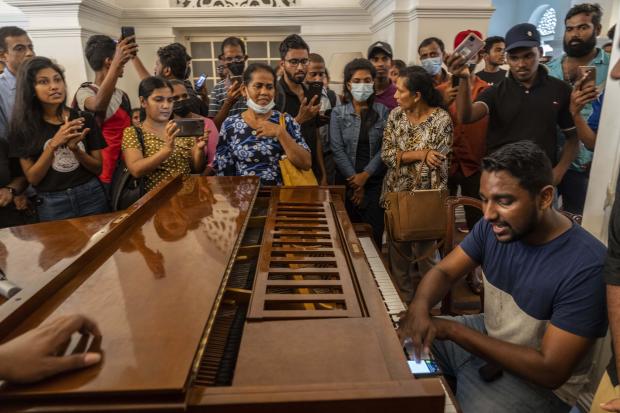Thousands of protesters were refusing to budge from the official residences of Sri Lanka‘s president and its prime minister on Monday, having occupied both homes for days. A wave of national outrage over the cost of living in the impoverished country appeared set to toppled its leaders, and the largely peaceful sit-ins of both men’s opulent homes — and the protesters’ refusal to leave — was literal and symbolic representation of the defiance.
The prime minister’s office confirmed Monday that President Gotabaya Rajapaksa would resign on Wednesday — which would meet one key demand of the protesters.
Massive demonstrations ramped up over the weekend in the South Asian island nation of 22 million people, which sits just off India’s southeast coast. Sri Lanka has been mired in an economic crisis for months, and feeling their plight was being not only unresolved, but unrecognized by their leaders, thousands of angry protesters swarmed the president’s official residence in Colombo on Saturday.
Protesters also set fire to Prime Minister Ranil Wickremesinghe’s private residence on Saturday. He has refused to step down until a new government is formed.
The protesters are demanding the immediate departure of both men, blaming them for the mismanagement of Sri Lanka’s economy.
Rajapaksa has not spoken publicly since his residence was stormed Saturday. Reports suggest he may be on a navy vessel off the coast.
Despite assurances from the head of the country’s parliament that the president would step down, the protesters have refused to leave his seafront mansion, though the president himself has not been seen for days.
Videos posted online and aired by news outlets have shown protesters running through the lavish residence, some taking a dip in the garden pool while others lounge on beds or take advantage of the showers.
How did it come to this?
Sri Lanka has been short of cash for months and struggling to pay for imports of essentials including food and fuel. The government blamed the COVID-19 pandemic for sapping the country’s tourism income, which is a main economic driver in Sri Lanka. But economists say there are other factors, including political corruption and economic mismanagement.
The country has defaulted on its huge foreign debt of $51 billion and is unable to make interest payments on its loans. While the government is in talks with the International Monetary Fund (IMF) for a $3 billion bailout package, for the time being it has been forced to rely on help from India and China.
President Rajapaksa has also been criticized for big tax cuts he introduced in 2019, which cost the government more than $1.4 billion a year. His government also banned chemical fertilizers last year to boost organic farming — a move that caught farmers by surprise and resulted in crop failure, eventually forcing the government to import food, exacerbating its foreign currency shortage.
The value of the Sri Lankan rupee has collapsed by 80% over the last few months, making imports more expensive and worsening inflation. Food costs have risen more than 50%. The confluence of factors has left Sri Lanka staring at national bankruptcy, with hardly any cash left to import essentials, and that has made everyday life for millions of people a struggle.
Over the last few months, Sri Lankans have faced up to 12-hour daily power cuts in the sweltering summer heat, a dire fuel shortage that saw thousands lining up at gas stations just to get a gallon or so of hugely expensive fuel, and an acute shortage of food and medicines.
Anger at the government only mushroomed as protesters started getting into the leaders’ homes and revealing the level of luxury the president enjoyed while many in his country faced hunger.
What’s next for Sri Lanka?
It could be weeks or months before the country’s food and fuel supplies start to normalize, even if the IMF does offer a bailout package soon. Speaker of the Parliament Mahinda Yapa Abeywardena has said that a new coalition government would need to be formed within a week of the president officially stepping down, and opposition political parties held talks Sunday to discuss the formation of a new government. More talks were expected in the coming days.
According to the country’s constitution, if both the president and prime minister resign, the Speaker of Parliament should take over as interim president.
But with the apparent, sudden collapse of the government, it’s unclear when a new full government might be formed, or whether whatever leadership does emerge will be trusted by the country’s people or the foreign entities trying to help the island nation.
In addition to a possible IMF bailout, the World Bank has agreed to lend Sri Lanka $600 million. India has promised to help with $1.9 billion and may lend an additional $1.5 billion for imports. The G7 group of countries — the U.S., Canada, France, Germany, Italy, Japan, and the U.K. — have said they’ll provide help to Sri Lanka in securing debt relief.
But it seemed there were still several days, if not weeks of uncertainty ahead for the beleaguered Sri Lankan people before any of the potential bailouts might start to provide some relief on ground.
This article was first published in CBS News . All contents and images are copyright to their respective owners and sources.













